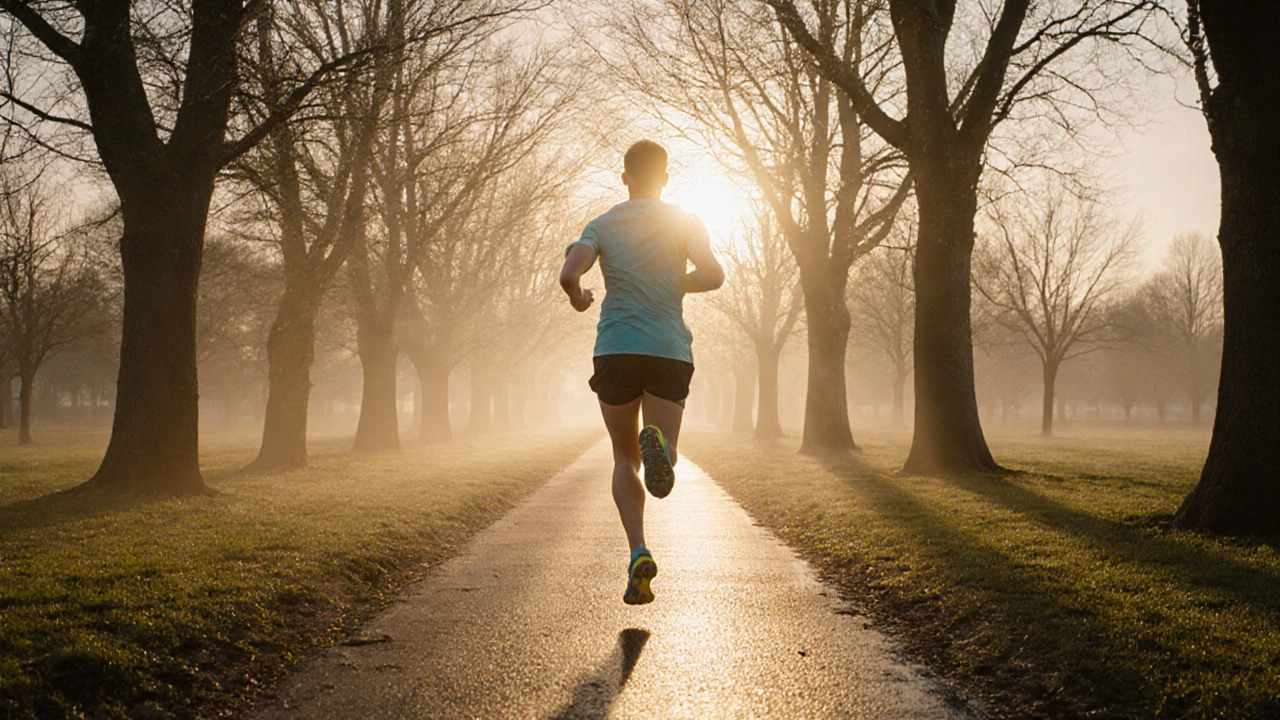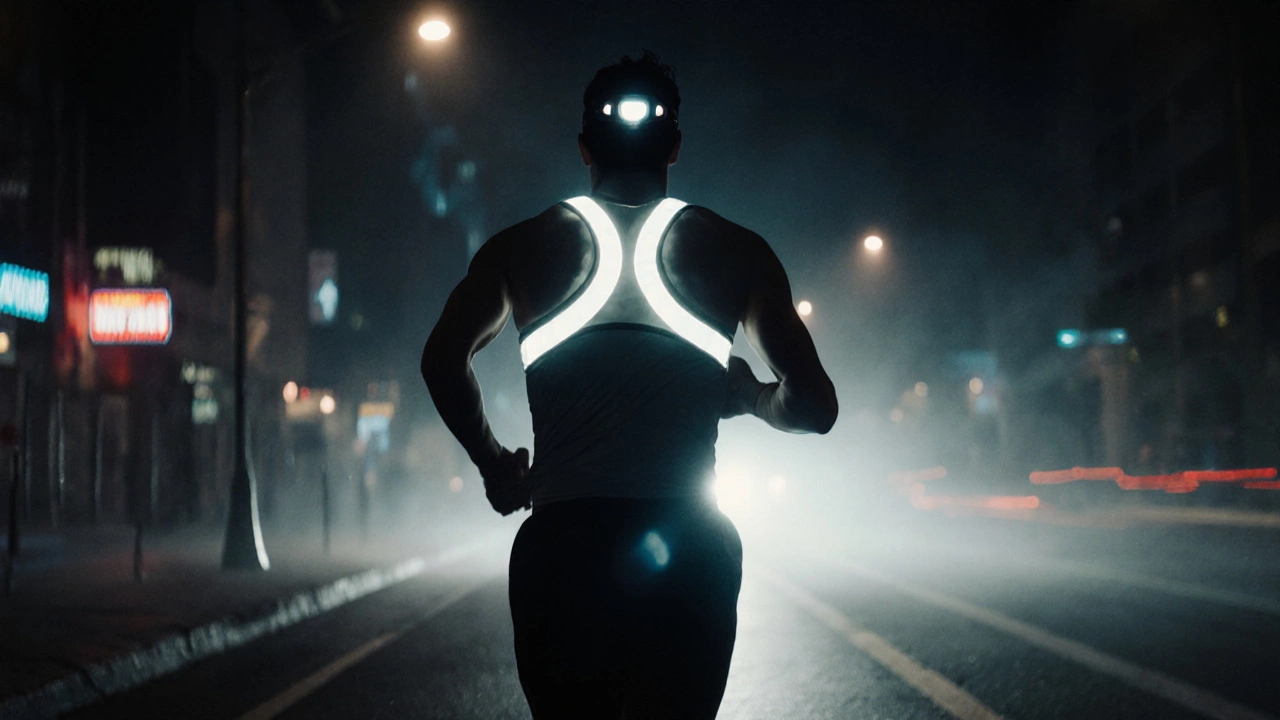Morning vs Night Running: Which Time Boosts Performance?

Ever wondered whether lacing up at sunrise or after sundown gives you the edge? Morning Running refers to jogging or sprint sessions that start before 10 am, often before work or school. Night Running covers runs that begin after 6 pm, typically when daylight fades. Both have loyal fans, but the science, safety and personal fit differ enough to affect your results. Below we break down the key factors so you can decide the best time to run for your goals, health and lifestyle.
Quick Takeaways
- Morning runs favor higher cortisol, cooler temps, and a metabolism kick‑start.
- Night runs enjoy lower air pollutants, relaxed muscles, and can improve sleep if timed right.
- Safety, personal schedule and climate are often the deciding factors.
- Mixing both times can give you the best of both worlds.
- Use the comparison table to match your priorities with the right slot.
1. How Your Body’s Clock Shapes Performance
Your Circadian Rhythm is the 24‑hour internal clock that regulates hormone release, body temperature and alertness. In the early morning, cortisol peaks, priming you for alertness and mobilising glucose. This hormonal surge can translate into a slightly higher perceived effort but also a sharper focus.
After dusk, melatonin starts to rise, signaling your body to wind down. While melatonin can make you feel sleepy, it also promotes recovery and reduces inflammation, which many runners find helpful for easy‑pace or recovery runs.
Research from the Journal of Sports Sciences (2023) shows that VO₂max tends to be about 5 % higher in the late afternoon, yet sprint performance can peak in the early morning for some individuals due to higher adrenaline levels. The takeaway? Your peak performance window is personal, but the hormonal backdrop definitely matters.
2. Temperature, Air Quality and Weather
Morning air is typically cooler, especially in spring and autumn. Lower ambient temperature means less cardiovascular strain and a lower risk of overheating. However, humidity can be higher, making the air feel heavier.
Nighttime runs often benefit from reduced traffic‑related pollutants. A 2022 study in Environmental Health found that PM2.5 levels drop by up to 40 % after rush‑hour, giving night runners cleaner lungs. On the flip side, temperature can rise in summer evenings, and dew can make surfaces slippery.
When planning, check your local forecast for temperature swings and use a simple rule: if it’s above 20 °C (68 °F) in the morning, consider a cooler evening run; if night temps stay above 25 °C (77 °F), stick to early morning.
3. Safety and Visibility
Running in daylight naturally offers better visibility-both for you spotting hazards and for motorists seeing you. Reflective gear is still advisable, but the risk of trips over uneven pavement drops significantly.
Night runs demand extra precautions: high‑visibility clothing, headlamps, and routes with good street lighting. If you run alone, choose well‑traveled paths or join a local running group. Studies from the University of Leeds (2021) indicate that nighttime injuries are 12 % higher mainly due to reduced visibility.
Safety isn’t just about traffic. Personal security concerns-especially for solo female runners-can tilt the decision toward daylight hours.

4. Sleep, Recovery and Hormonal Balance
Morning exercise can advance your circadian phase, making you feel sleepier earlier in the evening-a plus if you struggle with late‑night scrolling. Yet, an intense morning session may elevate heart rate for hours, potentially delaying sleep onset for sensitive individuals.
A gentle evening run, finished at least 90 minutes before bedtime, can boost melatonin production and improve sleep depth. A 2024 meta‑analysis in Sleep Medicine reported a 0.3‑hour increase in total sleep time for participants who exercised moderately after 6 pm compared to those who exercised only in the morning.
Balance is key: avoid high‑intensity sprints within two hours of bedtime if you’re prone to insomnia.
5. Pace, Endurance and Performance Metrics
Because body temperature peaks in the late afternoon, many runners experience a natural boost in muscle elasticity and nerve conduction, leading to faster paces. This explains why elite athletes often schedule time trials around 4‑6 pm.
Conversely, morning runs are ideal for steady‑state cardio, fat oxidation and building discipline. If your goal is weight loss or aerobic base building, the slightly lower intensity of a sunrise jog can be more sustainable.Tracking your own heart‑rate variability (HRV) across different times can provide personalized insight. A consistent drop in HRV after night runs suggests insufficient recovery, whereas stable HRV after morning runs signals good adaptability.
6. Lifestyle Fit: Work, Family and Personal Preference
Practicality often outweighs physiological nuances. If your job starts at 9 am, a morning run may be the only realistic slot. Parents with school‑age children might favor evening runs after dinner.
Consider your mental state, too. Some people thrive on the quiet solitude of dawn, while others enjoy the social vibe of evening park runs. Try a week of each and note how you feel-energy levels, mood, and adherence are strong predictors of long‑term success.
7. Decision Guide: Pick the Slot That Matches Your Priorities
- Goal‑Oriented: Want faster race times? Lean toward late‑day runs for peak power. Target weight loss? Morning runs may boost daily calorie burn.
- Environment: Live in a hot climate? Early morning is safer. Urban commuter? Evening runs may have cleaner air.
- Safety: If street lighting is poor, stick to daylight.
- Sleep Needs: If you struggle falling asleep, schedule runs before 10 am.
- Schedule Flexibility: Choose the slot you can repeat consistently for at least 8 weeks.
When in doubt, blend both: reserve mornings for easy runs and evenings for tempo work or social jogs.
8. Sample Weekly Plan (Mix & Match)
- Monday - Morning: 30‑minute easy run (60 % MHR)
- Tuesday - Evening: 45‑minute tempo run (80 % MHR)
- Wednesday - Morning: Strength‑focused hill repeats (short bursts)
- Thursday - Evening: 60‑minute steady state, focus on breathing
- Friday - Morning: 20‑minute recovery jog, optional stretching
- Saturday - Evening: Group run or race‑pace effort
- Sunday - Rest or gentle night walk
This schedule leverages the metabolic boost of mornings and the performance edge of evenings while keeping injury risk low.
Comparison Table: Morning vs Night Running
| Factor | Morning Running | Night Running |
|---|---|---|
| Hormone profile | Higher cortisol → increased alertness | Higher melatonin → better recovery |
| Temperature | Cooler, less heat stress | Varies; can be warm in summer evenings |
| Air quality | Potentially higher traffic pollutants | Reduced PM2.5 after rush hour |
| Safety | High visibility, lower accident risk | Requires reflective gear, well‑lit routes |
| Sleep impact | Can advance sleep onset, vigorous sessions may delay sleep | Gentle runs improve sleep; intense late sessions may disrupt |
| Performance potential | Good for endurance, metabolism kick‑start | Peak muscle temperature → faster paces |
Final Thoughts
There’s no universal answer. The "better" slot hinges on how your body reacts, what the environment offers, and where your day fits. Test both, track a few metrics (pace, HRV, sleep quality) and settle on the time that feels sustainable. Remember, consistency beats perfection-run when you’ll actually lace up.
Does running at night affect my sleep?
A moderate‑intensity run finished at least 90 minutes before bed usually raises melatonin and can improve sleep depth. High‑intensity sprints closer to bedtime may raise heart rate and delay sleep onset for sensitive sleepers.
Which time of day burns more fat?
Morning runs, especially on an empty stomach, tend to rely more on stored fat for fuel. However, total daily calorie burn matters more than the exact hour you run.
Is it safer to run in the morning?
Generally, daylight improves visibility for both runner and drivers, reducing collision risk. If you run at night, use reflective gear, a headlamp, and stick to well‑lit routes to mitigate the safety gap.
Can I mix morning and night runs in the same week?
Absolutely. Many runners schedule easy runs in the morning and speed work in the evening. This approach balances hormonal benefits, temperature control and keeps training fresh.
How do I choose the best route for night running?
Pick routes with street lighting, avoid isolated trails, and consider parks that stay open after dark. Carry a lightweight LED headlamp and wear at least 400‑lumens of reflective clothing.